Charles E W Bean, Diaries, AWM38 3DRL 606/228/1 - Folder - Part 7
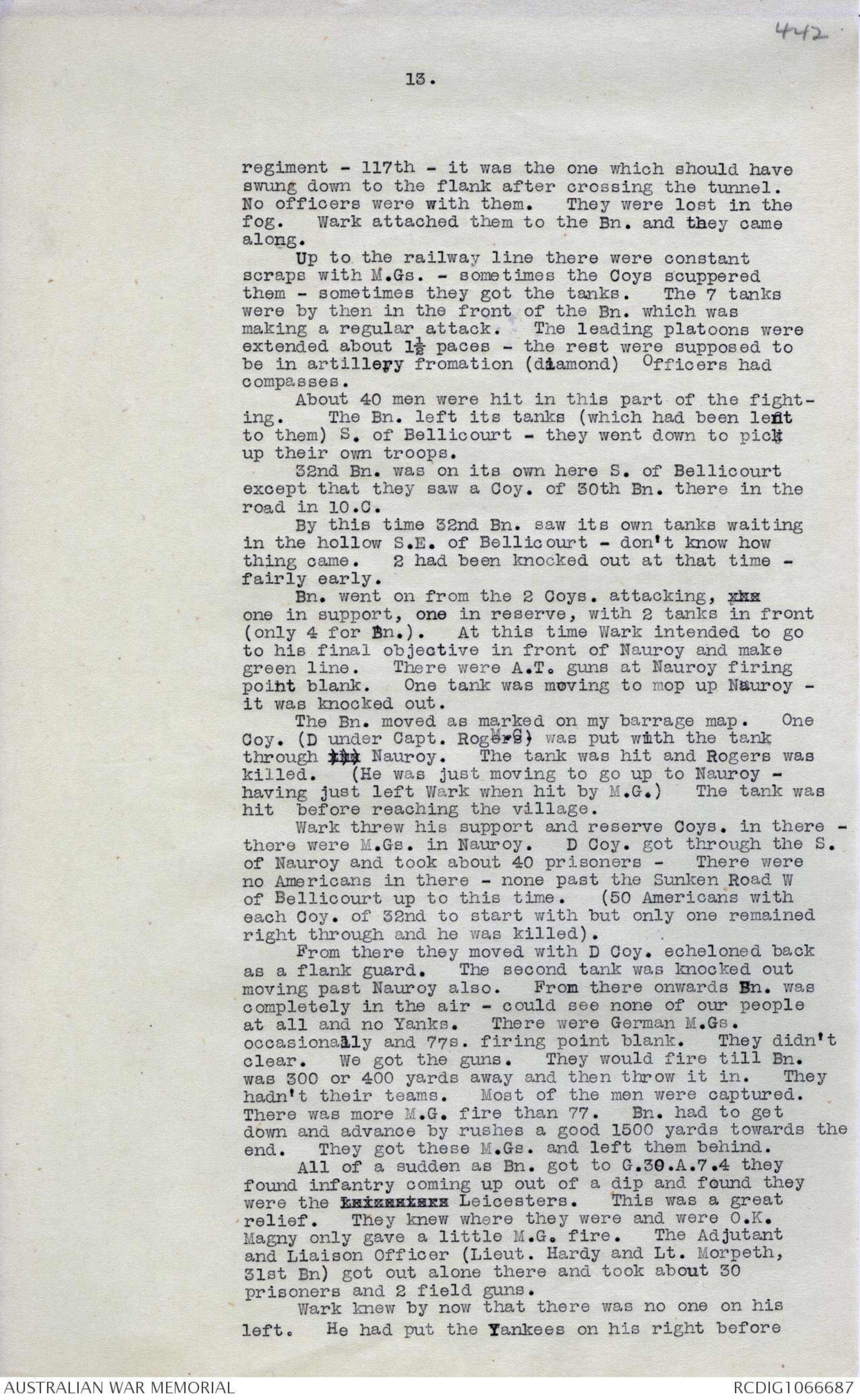
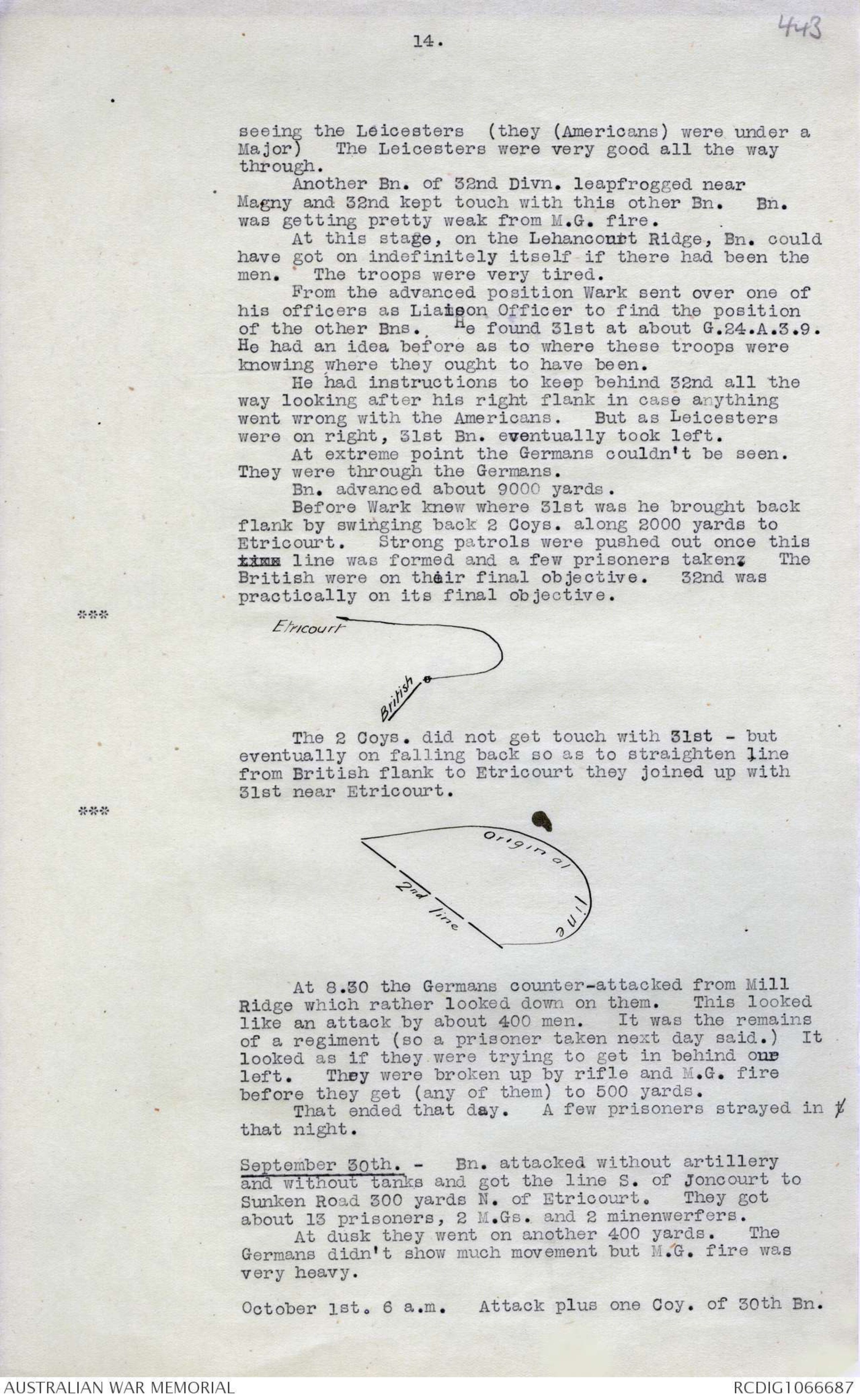
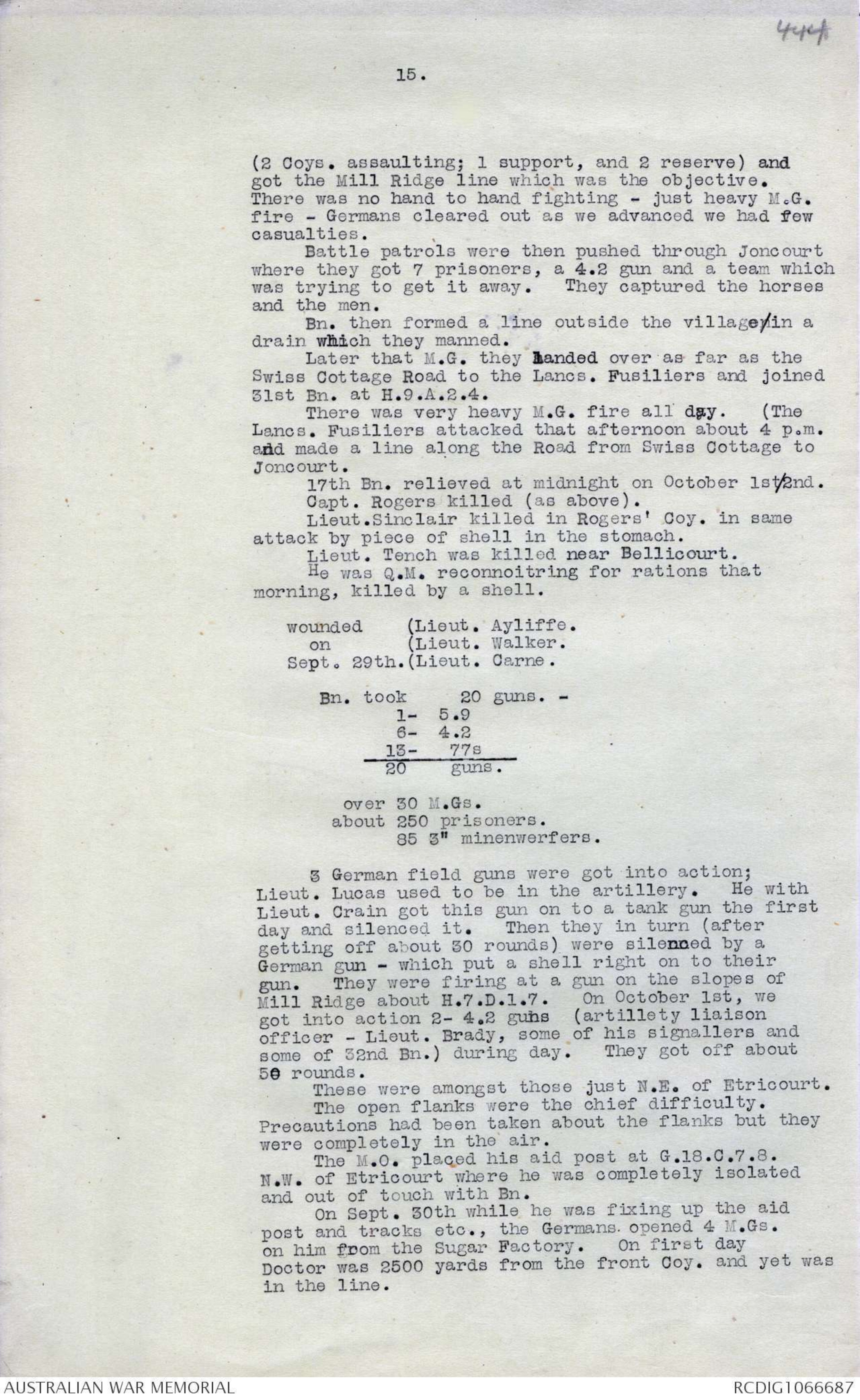
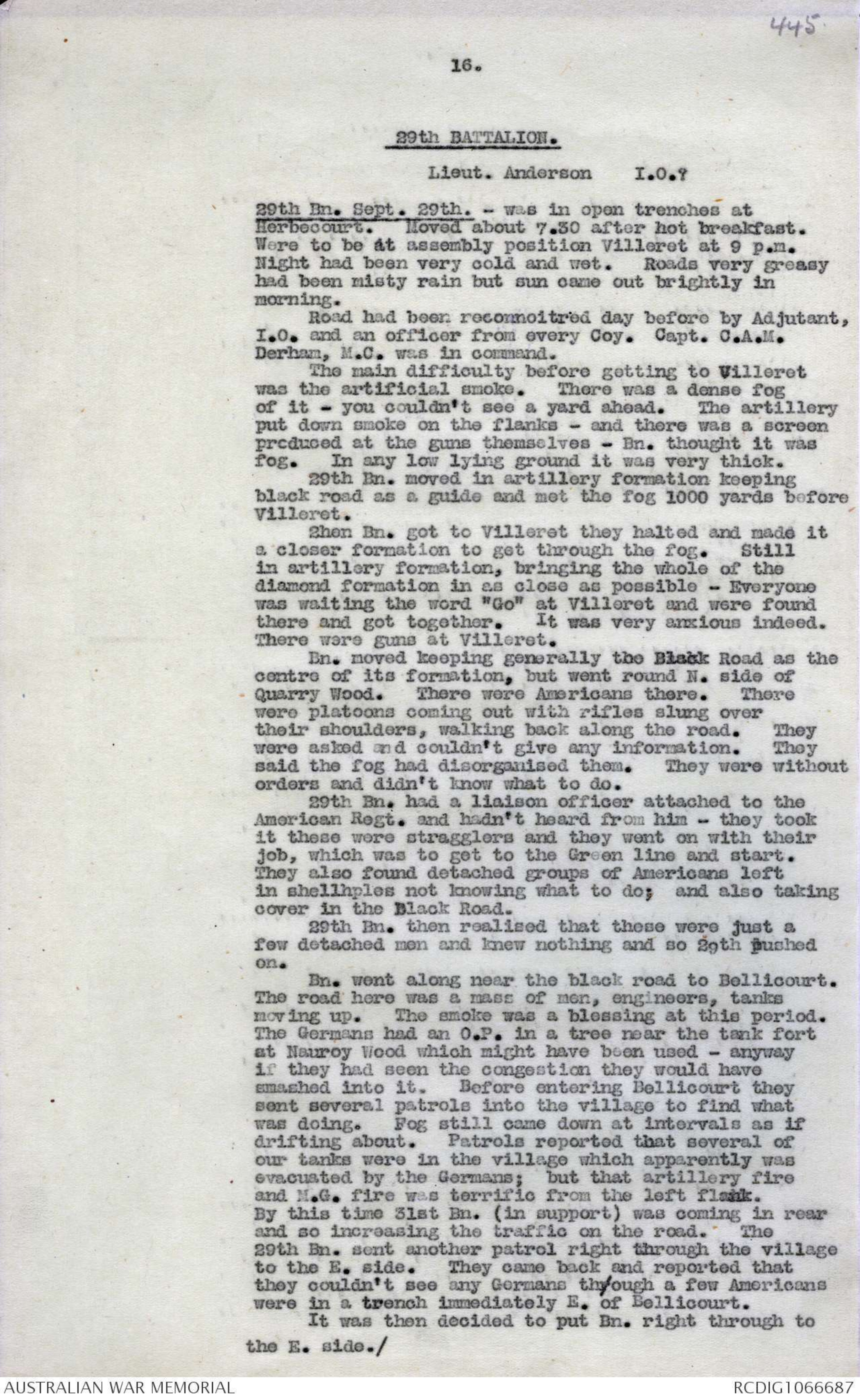
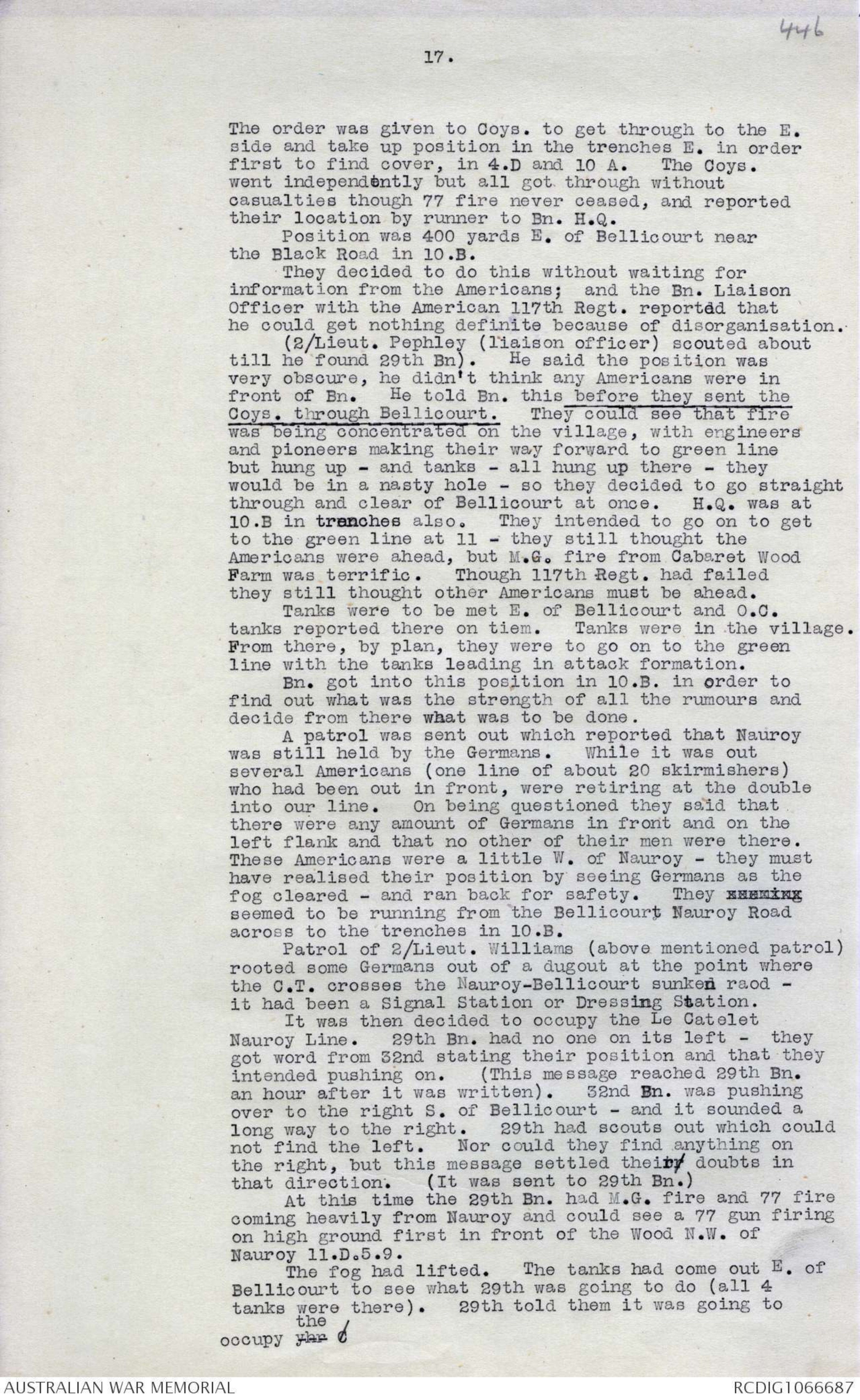
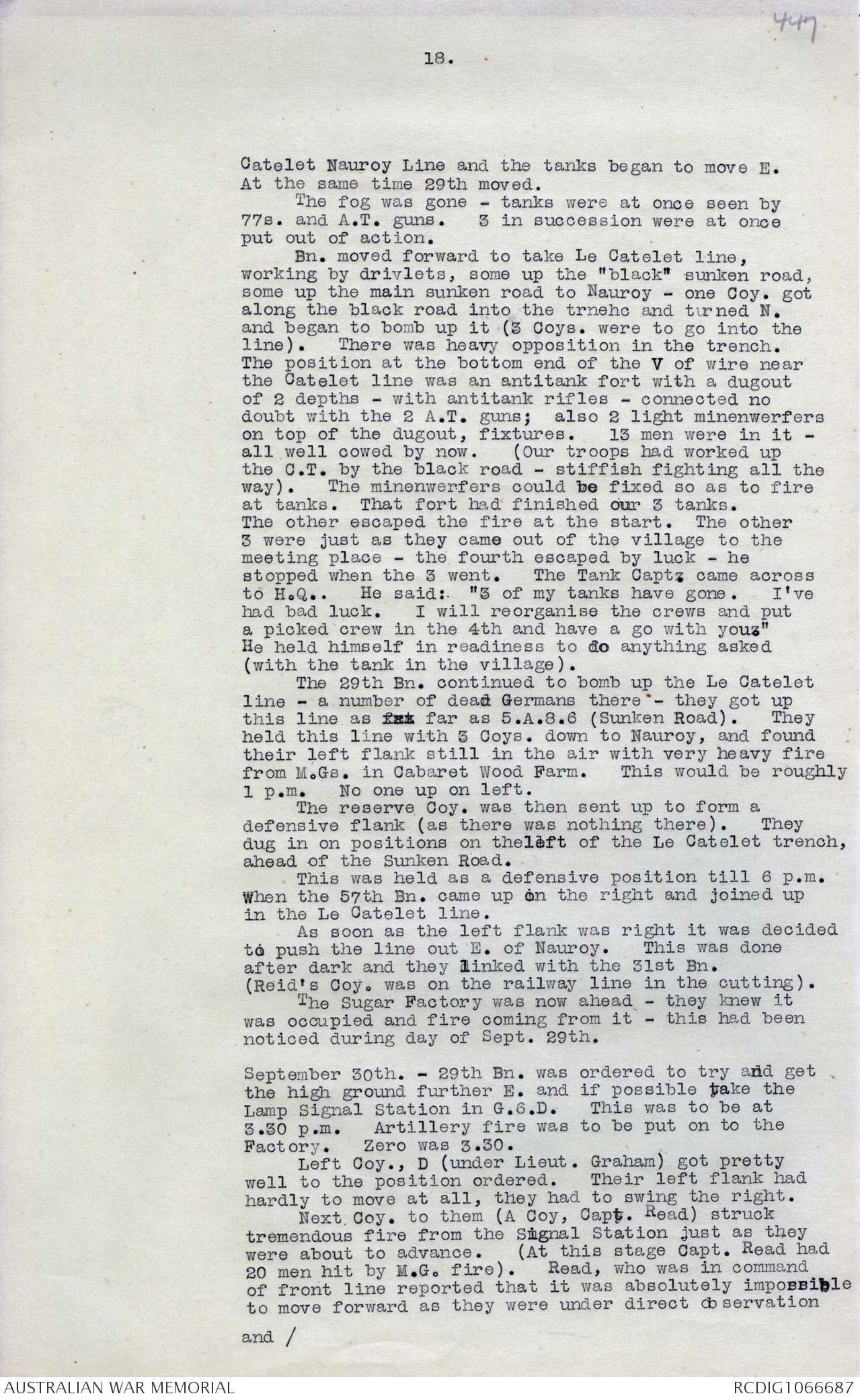
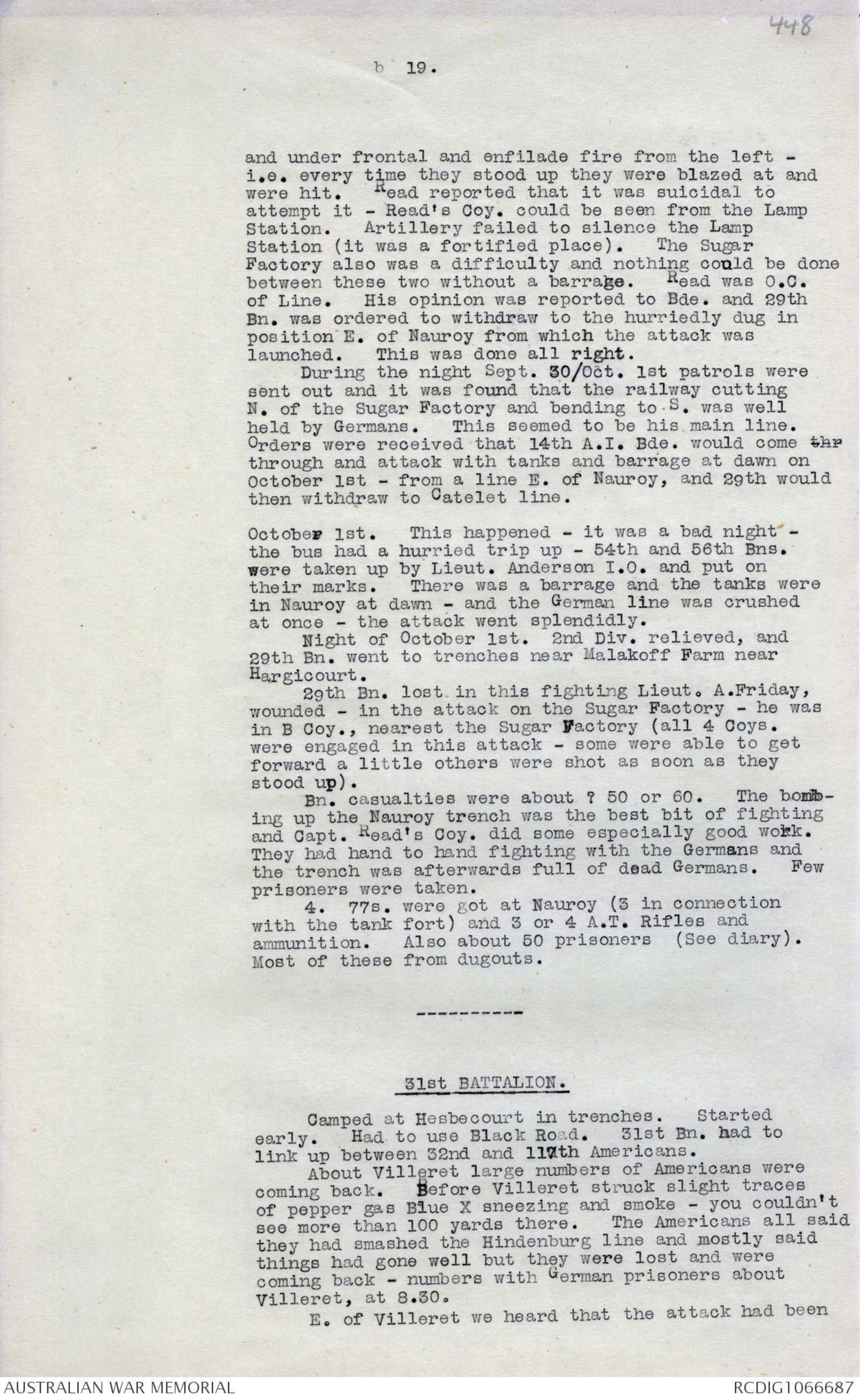
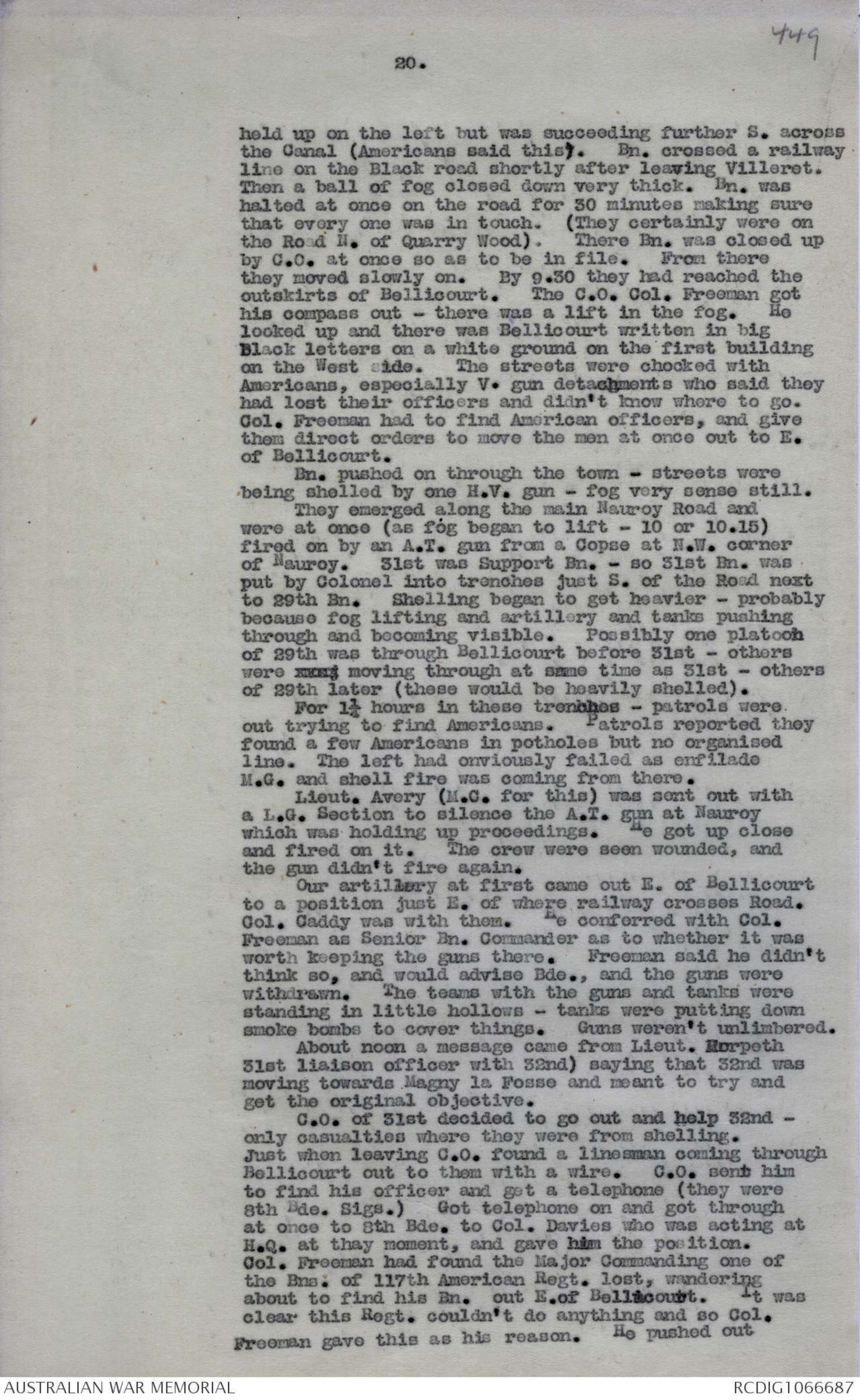
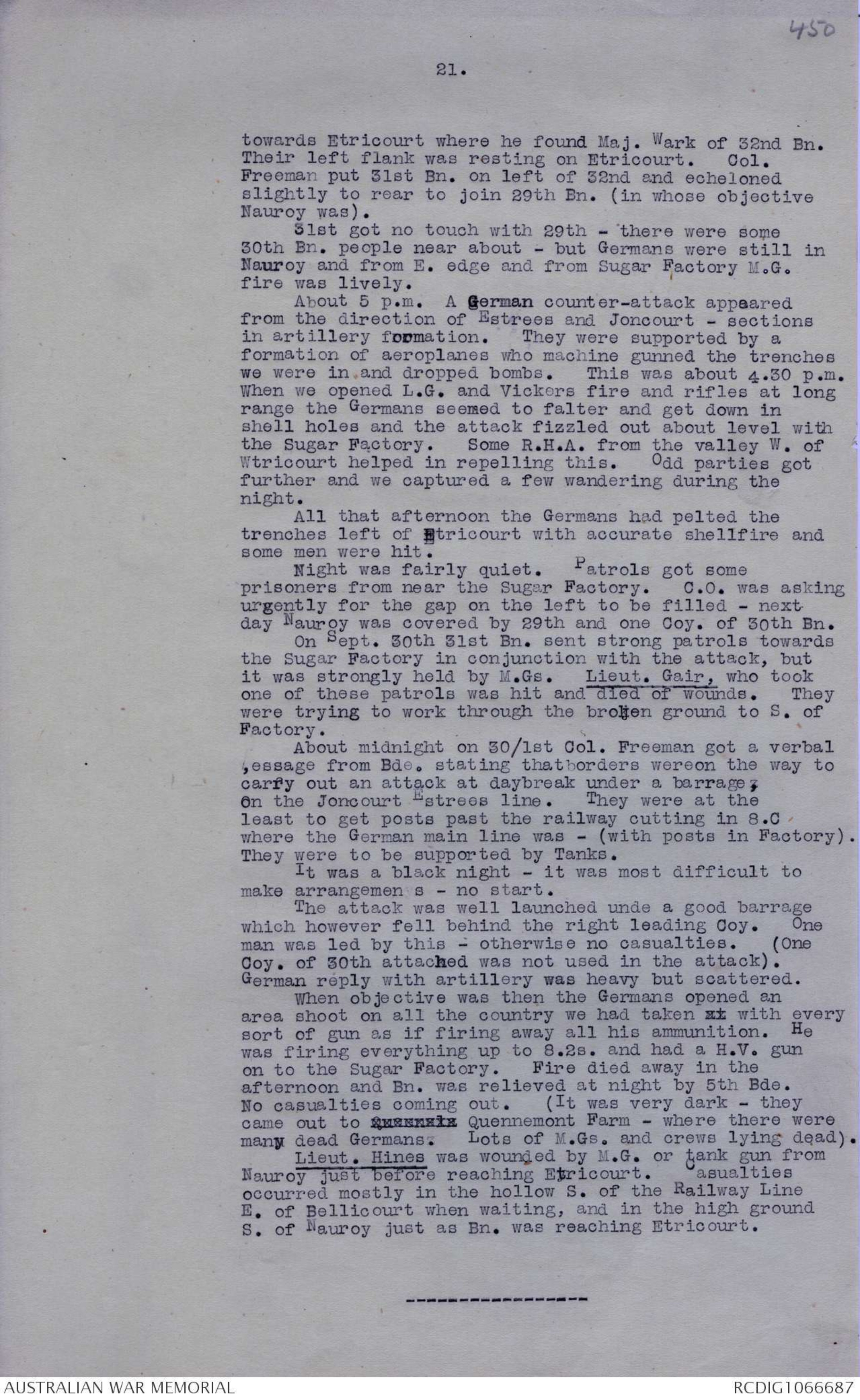
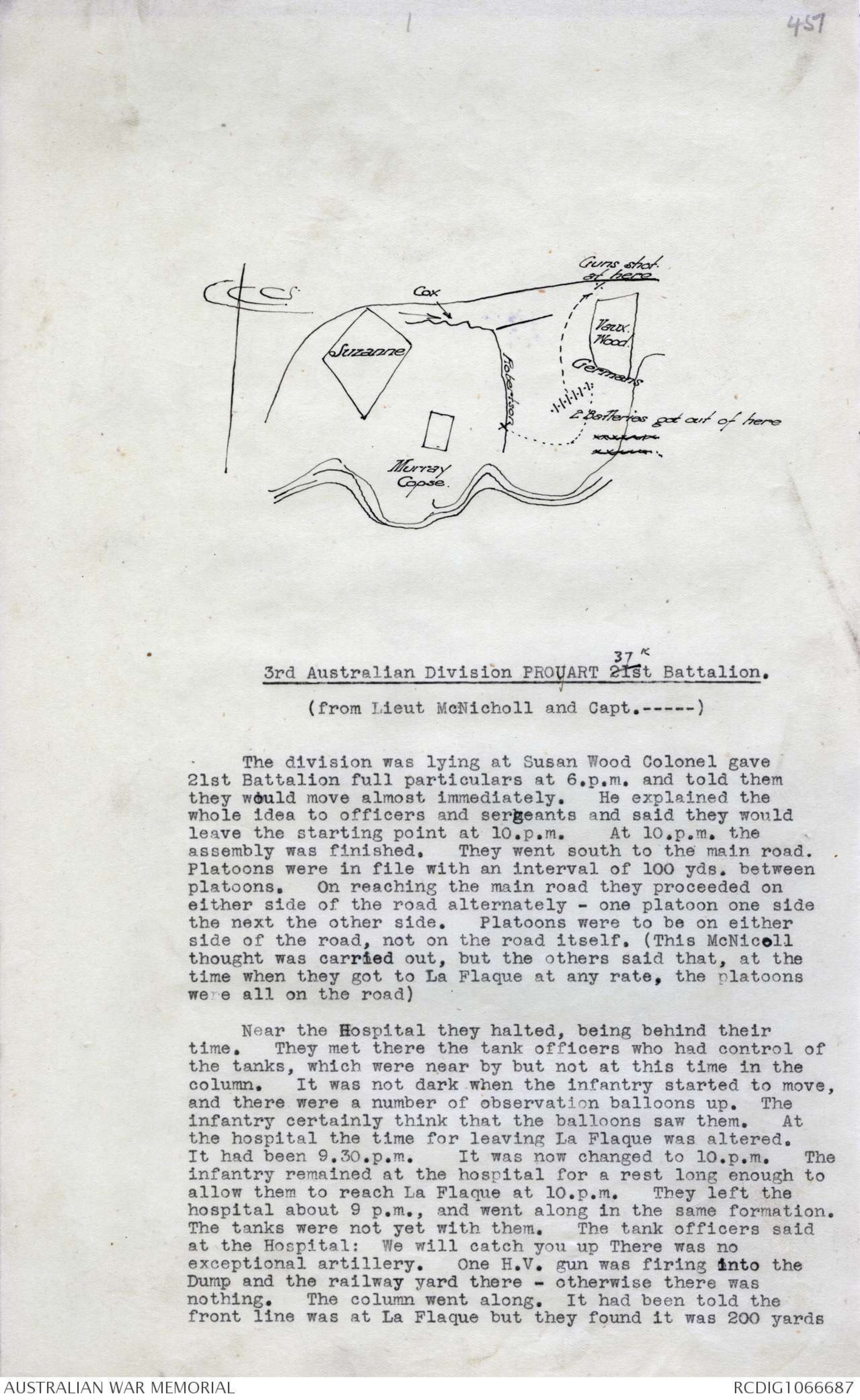
442
13.
regiment - 117th- it was the one which should have
swung down to the flank after crossing the tunnel.
No officers were with them. They were lost in the
fog. Wark attached them to the Bn. and they came
along.
Up to the railway line there were constant
scraps with M.Gs. - sometimes the Coys scuppered
them - sometimes they got the tanks. The 7 tanks
were by then in the front of the Bn. which was
making a regular attack. The leading platoons were
extended about 1½ paces - the rest were supposed to
be in artillery fromation (diamond) Officers had
compasses.
About 40 men were hit in this part of the fighting.
The Bn. left its tanks (which had been lent
to them) S. of Bellicourt - they went down to pick
up their own troops.
32nd Bn. was on its own here S. of Bellicourt
except that they saw a Coy. of 30th Bn. there in the
road in 10.C.
By this time 32nd Bn. saw its own tanks waiting
in the hollow S.E. of Bellicourt - don't know how
thing came. 2 had been knocked out at that time -
fairly early.
Bn. went on from the 2 Coys. attacking, xxx
one in support, one in reserve, with 2 tanks in front
(only 4 for Bn.). At this time Wark intended to go
to his final objective in front of Nauroy and make
green line. There were A.T. guns at Nauroy firing
point blank. One tank was moving to mop up Nauroy -
it was knocked out.
The Bn. moved as marked on my barrage map. One
Coy. (D under Capt. Rogers M.C.) was put with the tank
through ))) Nauroy. The tank was hit and Rogers was
killed. (He was just moving to go up to Nauroy -
having just left Wark when hit by M.G.) The tank was
hit before reaching the village.
Wark threw his support and reserve Coys. in there -
there were M.Gs. in Nauroy. D Coy. got through the S.
of Nauroy and took about 40 prisoners - There were
no Americans in there - none past the Sunken Road W
of Bellicourt up to this time. (50 Americans with
each Coy. of 32nd to start with but only one remained
right through and he was killed).
From there they moved with D Coy. echeloned back
as a flank guard. The second tank was knocked out
moving past Nauroy also. From there onwards Bn. was
completely in the air - could see none of our people
at all and no Yanks. There were German M.Gs.
occasionally and 77s. firing point blank. They didn't
clear. We got the guns. They would fire till Bn.
was 300 or 400 yards away and then throw it in. They
hadn't their teams. Most of the men were captured.
There was more M.G. fire than 77. Bn. had to get
down and advance by rushes a good 1500 yards towards the
end. They got these M.Gs. and left them behind.
All of a sudden as Bn. got to G.30.A.7.4 they
found infantry coming up out of a dip and found they
were the Leicesters Leicesters. This was a great
relief. They knew where they were and were O.K.
Magny only gave a little M.G. fire. The Adjutant
and Liaison Officer (Lieut. Hardy and Lt. Morpeth,
31st Bn) got out alone there and took about 30
prisoners and 2 field guns.
Wark knew by now that there was no one on his
left. He had put the Yankees on his right before
443
14.
seeing the Leicesters (they (Americans) were under a
Major) The Leicesters were very good all the way
through.
Another Bn. of 32nd Divn. leapfrogged near
Magny and 32nd kept touch with this other Bn. Bn.
was getting pretty weak from M.G. fire.
At this stage, on the Lehancourt Ridge, Bn. could
have got on indefinitely itself if there had been the
men. The troops were very tired.
From the advanced position Wark sent over one of
his officers as Liaison Officer to find the position
of the other Bns. He found 31st at about G.24.A.3.9.
He had an idea before as to where these troops were
knowing where they ought to have been.
He had instructions to keep behind 32nd all the
way looking after his right flank in case anything
went wrong with the Americans. But as Leicesters
were on right, 31st Bn. eventually took left.
At extreme point the Germans couldn't be seen.
They were through the Germans.
Bn. advanced about 9000 yards.
Before Wark knew where 31st was he brought back
flank by swinging back 2 Coys. along 2000 yards to
Etricourt. Strong patrols were pushed out once thisxxxx line was formed and a few prisoners takenz. The
British were on their final objective. 32nd was
practically on its final objective.
Diagram- see original document
The 2 Coys. did not get touch with 31st - but
eventually on falling back so as to straighten line
from British flank to Etricourt they joined up with
31st near Etricourt.
Diagram - see original document
At 8.30 the Germans counter-attacked from Mill
Ridge which rather looked down on them. This looked
like an attack by about 400 men. It was the remains
of a regiment (so a prisoner taken next day said.) It
looked as if they were trying to get in behind our
left. They were broken up by rifle and M.G. fire
before they get (any of them) to 500 yards.
That ended that day. A few prisoners strayed in t
that night.
September 30th. - Bn. attacked without artillery
and without tanks and got the line S. of Joncourt to
Sunken Road 300 yards N. of Etricourt. They got
about 13 prisoners, 2 M.Gs. and 2 minenwerfers.
At dusk they went on another 400 yards. The
Germans didn't show much movement but M.G. fire was
very heavy.
October 1st. 6 a.m. Attack plus one Coy. of 30th Bn.
444
15.
(2 Coys. assaulting; 1 support, and 2 reserve) and
got the Mill Ridge line which was the objective.
There was no hand to hand fighting - just heavy M.G.
fire - Germans cleared out as we advanced we had few
casualties.
Battle patrols were then pushed through Joncourt
where they got 7 prisoners, a 4.2 gun and a team which
was trying to get it away. They captured the horses
and the men.
Bn. then formed a line outside the villagenin a
drain which they manned.
Later that M.G. they handed over as far as the
Swiss Cottage Road to the Lancs. Fusiliers and joined
31st Bn. at H.9.A.2.4.
There was very heavy M.G. fire all day. (The
Lancs. Fusiliers attacked that afternoon about 4 p.m.
and made a line along the Road from Swiss Cottage to
Joncourt.
17th Bn. relieved at midnight on October 1st/2nd.
Capt. Rogers killed (as above).
Lieut. Sinclair killed in Rogers' Coy. in same
attack by piece of shell in the stomach.
Lieut. Tench was killed near Bellicourt.
He was Q.M. reconnoitring for rations that
morning, killed by a shell.
wounded (Lieut. Ayliffe.
on (Lieut. Walker.
Sept. 29th. (Lieut. Carne.
Bn. took 20 guns. -
1- 5.9
6- 4.2
13- 77s
———
20 guns.
over 30 M.Gs.
about 250 prisoners.
85 3" minenwerfers.
3 German field guns were got into action;
Lieut. Lucas used to be in the artillery. He with
Lieut. Crain got this gun on to a tank gun the first
day and silenced it. Then they in turn (after
getting off about 30 rounds) were silenced by a
German gun - which put a shell right on to their
gun. They were firing at a gun on the slopes of
Mill Ridge about H.7.D.1.7. On October 1st, we
got into action 2- 4.2 guns (artillety liaison
officer - Lieut. Brady, some of his signallers and
some of 32nd Bn.) during day. They got off about
50 rounds.
These were amongst those just N.E. of Etricourt.
The open flanks were the chief difficulty.
Precautions had been taken about the flanks but they
were completely in the air.
The M.O. placed his aid post at G.18.C.7.8.
N.W. of Etricourt where he was completely isolated
and out of touch with Bn.
On Sept. 30th while he was fixing up the aid
post and tracks etc., the Germans opened 4 M.Gs.
on him from the Sugar Factory. On first day
Doctor was 2500 yards from the front Coy. and yet was
in the line.
445
16.
29th BATTALION.
Lieut. Anderson I.0.?
29th Bn. Sept. 29th. - was in open trenches at
Herbecourt. Moved about 7.30 after hot breakfast.
Were to be at assembly position Villeret at 9 p.m.
Night had been very cold and wet. Roads very greasy
had been misty rain but sun came out brightly in
morning.
Road had been reconnoitred day before by Adjutant,
I.O. and an officer from every Coy. Capt. C.A.M.
Derham, M.C. was in command.
The main difficulty before getting to Villeret
was the artificial smoke. There was a dense fog
of it - you couldn't see a yard ahead. The artillery
put down smoke on the flanks - and there was a screen
produced at the guns themselves - Bn. thought it was
fog. In any low lying ground it was very thick.
29th Bn. moved in artillery formation keeping
black road as a guide and met the fog 1000 yards before
Villeret.
2hen Bn. got to Villeret they halted and made it
a closer formation to get through the fog. Still
in artillery formation, bringing the whole of the
diamond formation in as close as possible - Everyone
was waiting the word "Go" at Villeret and were found
there and got together. It was very anxious indeed.
There were guns at Villeret.
Bn. moved keeping generally the Black Road as the
centre of its formation, but went round N. side of
Quarry Wood. There were Americans there. There
were platoons coming out with rifles slung over
their shoulders, walking back along the road. They
were asked and couldn't give any information. They
said the fog had disorganised them. They were without
orders and didn't know what to do.
29th Bn. had a liaison officer attached to the
American Regt. and hadn't heard from him - they took
it these were stragglers and they went on with their
job, which was to get to the Green line and start.
They also found detached groups of Americans left
in shellhples not knowing what to do; and also taking
cover in the Black Road.
29th Bn. then realised that those were just a
few detached men and knew nothing and so 29th pushed
on.
Bn. went along near the black road to Bellicourt.
The road here was a mass of men, engineers, tanks
moving up. The smoke was a blessing at this period.
The Germans had an O.P. in a tree near the tank fort
at Nauroy Wood which might have been used - anyway
if they had seen the congestion they would have
smashed into it. Before entering Bellicourt they
sent several patrols into the village to find what
was doing. Fog still came down at intervals as if
drifting about. Patrols reported that several of
our tanks were in the village which apparently was
evacuated by the Germans; but that artillery fire
and M.G. fire was terrific from the left flank.
By this time 31st Bn. (in support) was coming in rear
and so increasing the traffic on the road. The
29th Bn. sent another patrol right through the village
to the E. side. They came back and reported that
they couldn't see any Germans through a few Americans
were in a trench immediately E. of Bellicourt.
It was then decided to put Bn. right through to
the E. side./
446
17.
The order was given to Coys. to get through to the E.
side and take up position in the trenches E. in order
first to find cover, in 4.D and 10 A. The Coys.
went independently but all got through without
casualties though 77 fire never ceased, and reported
their location by runner to Bn. H.Q.
Position was 400 yards E. of Bellicourt near
the Black Road in 10.B.
They decided to do this without waiting for
information from the Americans; and the Bn. Liaison
Officer with the American 117th Regt. reported that
he could get nothing definite because of disorganisation.
(2/Lieut. Pephley (liaison officer) scouted about
till he found 29th Bn). He said the position was
very obscure, he didn't think any Americans were in
front of Bn. He told Bn. this before they sent the
Coys. through Bellicourt. They could see that fire
was being concentrated on the village, with engineers
and pioneers making their way forward to green line
but hung up - and tanks - all hung up there - they
would be in a nasty hole - so they decided to go straight
through and clear of Bellicourt at once. H.Q. was at
10.B in trenches also. They intended to go on to get
to the green line at 11 - they still thought the
Americans were ahead, but M.G. fire from Cabaret Wood
Farm was terrific. Though 117th Regt. had failed
they still thought other Americans must be ahead.
Tanks were to be met E. of Bellicourt and O.C.
tanks reported there on tiem. Tanks were in the village.
From there, by plan, they were to go on to the green
line with the tanks leading in attack formation.
Bn. got into this position in 10.B. in order to
find out what was the strength of all the rumours and
decide from there what was to be done.
A patrol was sent out which reported that Nauroy
was still held by the Germans. While it was out
several Americans (one line of about 20 skirmishers)
who had been out in front, were retiring at the double
into our line. On being questioned they said that
there were any amount of Germans in front and on the
left flank and that no other of their men were there.
These Americans were a little W. of Nauroy - they must
have realised their position by seeing Germans as the
fog cleared - and ran back for safety. They xxxx
seemed to be running from the Bellicourt Nauroy Road
across to the trenches in 10.B.
Patrol of 2/Lieut. Williams (above mentioned patrol)
rooted some Germans out of a dugout at the point where
the C.T. crosses the Nauroy-Bellicourt sunken raod -
it had been a Signal Station or Dressing Station.
It was then decided to occupy the Le Catelet
Nauroy Line. 29th Bn. had no one on its left - they
got word from 32nd stating their position and that they
intended pushing on. (This message reached 29th Bn.
an hour after it was written). 32nd Bn. was pushing
over to the right S. of Bellicourt - and it sounded a
long way to the right. 29th had scouts out which could
not find the left. Nor could they find anything on
the right, but this message settled theirr doubts in
that direction. (It was sent to 29th Bn.)
At this time the 29th Bn. had M.G. fire and 77 fire
coming heavily from Nauroy and could see a 77 gun firing
on high ground first in front of the Wood N.W. of
Nauroy 11.D.5.9.
The fog had lifted. The tanks had come out E. of
Bellicourt to see what 29th was going to do (all 4
tanks were there). 29th told them it was going to
occupy yhr the C
447
18.
Catelet Nauroy Line and the tanks began to move E.
At the same time 29th moved.
The fog was gone - tanks were at once seen by
77s. and A.T. guns. 3 in succession were at once
put out of action.
Bn. moved forward to take Le Catelet line,
working by drivlets, some up the "black" sunken road,
some up the main sunken road to Nauroy - one Coy. got
along the black road into the trnehc and turned N.
and began to bomb up it (3 Coys. were to go into the
line). There was heavy opposition in the trench.
The position at the bottom end of the V of wire near
the Catelet line was an antitank fort with a dugout
of 2 depths - with antitank rifles - connected no
doubt with the 2 A.T. guns; also 2 light minenwerfers
on top of the dugout, fixtures. 13 men were in it -
all well cowed by now. (Our troops had worked up
the C.T. by the black road - stiffish fighting all the
way). The minenwerfers could be fixed so as to fire
at tanks. That fort had finished our 3 tanks.
The other escaped the fire at the start. The other
3 were just as they came out of the village to the
meeting place - the fourth escaped by luck - he
stopped when the 3 went. The Tank Captz. came across
to H.Q.. He said: "3 of my tanks have gone. I've
had bad luck. I will reorganise the crews and put
a picked crew in the 4th and have a go with youz."
He held himself in readiness to do anything asked
(with the tank in the village).
The 29th Bn. continued to bomb up the Le Catelet
line - a number of dead Germans there'- they got up
this line as xxxx far as 5.A.8.6 (Sunken Road). They
held this line with 3 Coys. down to Nauroy, and found
their left flank still in the air with very heavy fire
from M.Gs. in Cabaret Wood Farm. This would be roughly
1 p.m. No one up on left.
The reserve Coy. was then sent up to form a
defensive flank (as there was nothing there). They
dug in on positions on theleft of the Le Catelet trench,
ahead of the Sunken Road.
This was held as a defensive position till 6 p.m.
When the 57th Bn. came up on the right and joined up
in the Le Catelet line.
As soon as the left flank was right it was decided
to push the line out E. of Nauroy. This was done
after dark and they linked with the 31st Bn.
(Reid's Coy. was on the railway line in the cutting).
The Sugar Factory was now ahead - they knew it
was occupied and fire coming from it - this had been
noticed during day of Sept. 29th.
September 30th. - 29th Bn. was ordered to try and get
the high ground further E. and if possible take the
Lamp Signal Station in G.6.D. This was to be at
3.30 p.m. Artillery fire was to be put on to the
Factory. Zero was 3.30.
Left Coy., D (under Lieut. Graham) got pretty
well to the position ordered. Their left flank had
hardly to move at all, they had to swing the right.
Next Coy. to them (A Coy, Capt. Read) struck
tremendous fire from the Signal Station just as they
were about to advance. (At this stage Capt. Read had
20 men hit by M.G. fire). Read, who was in command
of front line reported that it was absolutely impossible
to move forward as they were under direct observation
and /
448
b 19.
and under frontal and enfilade fire from the left -
i.e. every time they stood up they were blazed at and
were hit. Read reported that it was suicidal to
attempt it - Read's Coy. could be seen from the Lamp
Station. Artillery failed to silence the Lamp
Station (it was a fortified place). The Sugar
Factory also was a difficulty and nothing could be done
between these two without a barrage. Read was O.C.
of Line. His opinion was reported to Bde. and 29th
Bn. was ordered to withdraw to the hurriedly dug in
position E. of Nauroy from which the attack was
launched. This was done all right.
During the night Sept. 30/Oct. 1st patrols were
sent out and it was found that the railway cutting
N. of the Sugar Factory and bending to S. was well
held by Germans. This seemed to be his main line.
Orders were received that 14th A.I. Bde. would come thr
through and attack with tanks and barrage at dawn on
October 1st - from a line E. of Nauroy, and 29th would
then withdraw to Catelet line.
October lst. This happened - it was a bad night -
the bus had a hurried trip up - 54th and 56th Bns.
were taken up by Lieut. Anderson I.O. and put on
their marks. There was a barrage and the tanks were
in Nauroy at dawn - and the German line was crushed
at once - the attack went splendidly.
Night of October 1st. 2nd Div. relieved, and
29th Bn. went to trenches near Malakoff Farm near
Hargicourt.
29th Bn. lost in this fighting Lieut. A.Friday,
wounded - in the attack on the Sugar Factory - he was
in B Coy., nearest the Sugar Factory (all 4 Coys.
were engaged in this attack - some were able to get
forward a little others were shot as soon as they
stood up).
Bn. casualties were about ? 50 or 60. The bombing
up the Nauroy trench was the best bit of fighting
and Capt. Read's Coy. did some especially good work.
They had hand to hand fighting with the Germans and
the trench was afterwards full of dead Germans. Few
prisoners were taken.
4. 77s. were got at Nauroy (3 in connection
with the tank fort) and 3 or 4 A.T. Rifles and
ammunition. Also about 50 prisoners (See diary).
Most of these from dugouts.
31st BATTALION.
Camped at Hesbecourt in trenches. Started
early. Had to use Black Road. 31st Bn. had to
link up between 32nd and 117th Americans.
About Villeret large numbers of Americans were
coming back. Before Villeret struck slight traces
of pepper gas Blue X sneezing and smoke - you couldn't
see more than 100 yards there. The Americans all said
they had smashed the Hindenburg line and mostly said
things had gone well but they were lost and were
coming back - numbers with German prisoners about
Villeret, at 8.30.
E. of Villeret we heard that the attack had been
449
20.
held up on the left but was succeeding further S. across
the Canal (Americans said this). Bn. crossed a railway
line on the Black road shortly after leaving Villeret.
Then a ball of fog closed down very thick. Bn. was
halted at once on the road for 30 minutes making sure
that every one was in touch. (They certainly were on
the Road N. of Quarry Wood). There Bn. was closed up
by C.O. at once so as to be in file. From there
they moved slowly on. By 9.30 they had reached the
outskirts of Bellicourt. The C.O. Col. Freeman got
his compass out - there was a lift in the fog. He
looked up and there was Bellicourt written in big
Black letters on a white ground on the first building
on the West side. The streets were chocked with
Americans, especially V. gun detachments who said they
had lost their officers and didn't know where to go.
Col. Freeman had to find American officers, and give
them direct orders to move the men at once out to E.
of Bellicourt.
Bn. pushed on through the town - streets were
being shelled by one H.V. gun - fog very sense still.
They emerged along the main Nauroy Road and
were at once (as fog began to lift - 10 or 10.15)
fired on by an A.T. gun from a Copse at N.W. corner
of Nauroy. 31st was Support Bn. - so 31st Bn. was
put by Colonel into trenches just S. of the Road next
to 29th Bn. Shelling began to get heavier - probably
because fog lifting and artillery and tanks pushing
through and becoming visible. Possibly one platoon
of 29th was through Bellicourt before 3lst - others
were xxxx moving through at same time as 31st - others
of 29th later (these would be heavily shelled).
For 1¼ hours in these trenches - patrols were
out trying to find Americans. Patrols reported they
found a few Americans in potholes but no organised
line. The left had onviously failed as enfilade
M.G. and shell fire was coming from there.
Lieut. Avery (M.C. for this) was sent out with
a L.G. Section to silence the A.T. gun at Nauroy
which was holding up proceedings. He got up close
and fired on it. The crew were seen wounded, and
the gun didn't fire again.
Our artillery at first came out E. of Bellicourt
to a position just E. of where railway crosses Road.
Col. Caddy was with them. He conferred with Col.
Freeman as Senior Bn. Commander as to whether it was
worth keeping the guns there. Freeman said he didn't
think so, and would advise Bde., and the guns were
withdrawn. The teams with the guns and tanks were
standing in little hollows - tanks were putting down
smoke bombs to cover things. Guns weren't unlimbered.
About noon a message came from Lieut. Morpeth
31st liaison officer with 32nd) saying that 32nd was
moving towards Magny la Fosse and meant to try and
get the original objective.
C.O. of 31st decided to go out and help 32nd -
only casualties where they were from shelling.
Just when leaving C.O. found a linesman coming through
Bellicourt out to them with a wire. C.O. sent him
to find his officer and get a telephone (they were
8th Bde. Sigs.) Got telephone on and got through
at once to 8th Bde. to Col. Davies who was acting at
H.Q. at thay moment, and gave him the position.
Col. Freeman had found the Major Commanding one of
the Bns. of 117th American Regt. lost, wandering
about to find his Bn. out E.of Bellicourt. It was
clear this Regt. couldn't do anything and so Col.
Freeman gave this as his reason. He pushed out
450
21.
towards Etricourt where he found Maj. Wark of 32nd Bn.
Their left flank was resting on Etricourt. Col.
Freeman put 31st Bn. on left of 32nd and echeloned
slightly to rear to join 29th Bn. (in whose objective
Nauroy was).
31st got no touch with 29th - there were some
30th Bn. people near about - but Germans were still in
Nauroy and from E. edge and from Sugar Factory M.G.
fire was lively.
About 5 p.m. A German counter-attack appeared
from the direction of Estrees and Joncourt - sections
in artillery formation. They were supported by a
formation of aeroplanes who machine gunned the trenches
we were in and dropped bombs. This was about 4.30 p.m.
When we opened L.G. and Vickers fire and rifles at long
range the Germans seemed to falter and get down in
shell holes and the attack fizzled out about level with
the Sugar Factory. Some R.H.A. from the valley W. of
Wtricourt helped in repelling this. Odd parties got
further and we captured a few wandering during the
night.
All that afternoon the Germans had pelted the
trenches left of Etricourt with accurate shellfire and
some men were hit.
Night was fairly quiet. Patrols got some
prisoners from near the Sugar Factory. C.O. was asking
urgently for the gap on the left to be filled - next
day Nauroy was covered by 29th and one Coy. of 30th Bn.
On Sept. 30th 31st Bn. sent strong patrols towards
the Sugar Factory in conjunction with the attack, but
it was strongly held by M.Gs. Lieut. Gair, who took
one of these patrols was hit and died of wounds. They
were trying to work through the broken ground to S. of
Factory.
About midnight on 30/1st Col. Freeman got a verbal
,essage from Bde, stating thatborders wereon the way to
carry out an attack at daybreak under a barrage,
on the Joncourt Estrees line. They were at the
least to get posts past the railway cutting in 8.C
where the German main line was - (with posts in Factory).
They were to be supported by Tanks.
It was a black night - it was most difficult to
make arrangemen s - no start.
The attack was well launched unde a good barrage
which however fell behind the right leading Coy. One
man was led by this - otherwise no casualties. (One
Coy. of 30th attached was not used in the attack).
German reply with artillery was heavy but scattered.
When objective was then the Germans opened an
area shoot on all the country we had taken xx with every
sort of gun as if firing away all his ammunition. He
was firing everything up to 8.2s. and had a H.V. gun
on to the Sugar Factory. Fire died away in the
afternoon and Bn. was relieved at night by 5th Bde.
No casualties coming out. (It was very dark - they
came out to xxxxx Quennemont Farm - where there were
many dead Germans. Lots of M.Gs. and crews lying dead).
Lieut. Hines was wounded by M.G. or tank gun from
Nauroy just before reaching Etricourt. Casualties
occurred mostly in the hollow S. of the Railway Line
E. of Bellicourt when waiting, and in the high ground
S. of Nauroy just as Bn. was reaching Etricourt.
457
Diagram - see original document
3rd Australian Division PROUART 21st 37th Battalion.
(from Lieut McNicholl and Capt.---)
The division was lying at Susan Wood Colonel gave
21st Battalion full particulars at 6.p.m. and told them
they would move almost immediately. He explained the
whole idea to officers and sergeants and said they would
leave the starting point at 10.p.m. At 10.p.m. the
assembly was finished. They went south to the main road.
Platoons were in file with an interval of 100 yds. between
platoons. On reaching the main road they proceeded on
either side of the road alternately - one platoon one side
the next the other side. Platoons were to be on either
side of the road, not on the road itself. (This McNicoll
thought was carried out, but the others said that, at the
time when they got to La Flaque at any rate, the platoons
were all on the road)
Near the Hospital they halted, being behind their
time. They met there the tank officers who had control of
the tanks, which were near by but not at this time in the
column. It was not dark when the infantry started to move,
and there were a number of observation balloons up. The
infantry certainly think that the balloons saw them. At
the hospital the time for leaving La Flaque was altered.
It had been 9.30.p.m. It was now changed to 10.p.m. The
infantry remained at the hospital for a rest long enough to
allow them to reach La Flaque at 10.p.m. They left the
hospital about 9 p.m., and went along in the same formation.
The tanks were not yet with them. The tank officers said
at the Hospital: We will catch you up There was no
exceptional artillery. One H.V. gun was firing into the
Dump and the railway yard there - otherwise there was
nothing. The column went along. It had been told the
front line was at La Flaque but they found it was 200 yards
 Loretta Corbett
Loretta CorbettThis transcription item is now locked to you for editing. To release the lock either Save your changes or Cancel.
This lock will be automatically released after 60 minutes of inactivity.